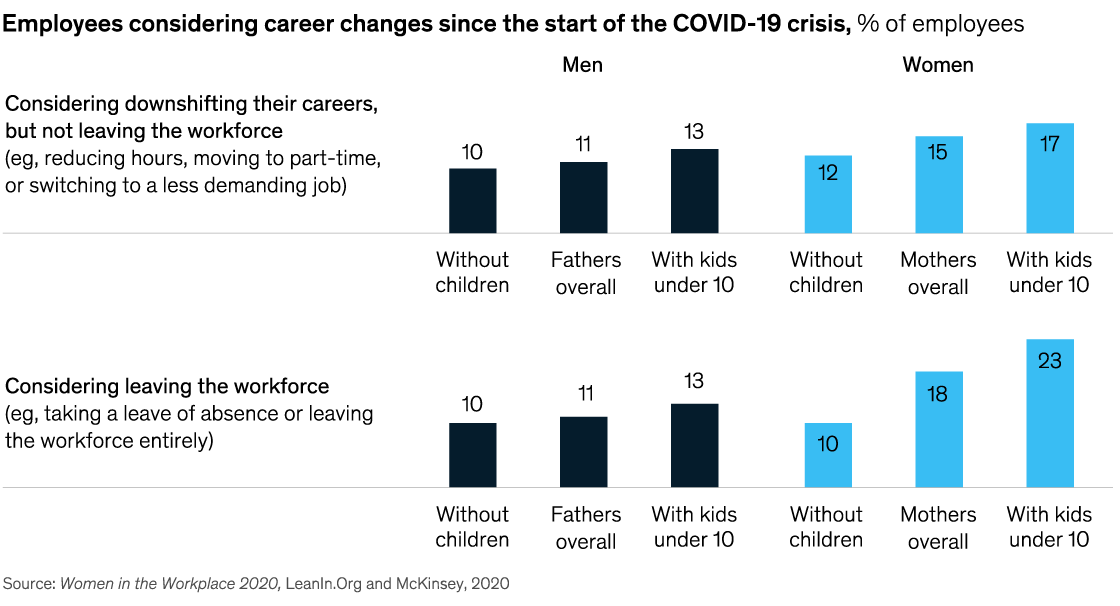| | |
 |
Edited by Justine Jablonska
(she/her/hers)
Editor, New York |
|
|
|
|
| |
|
Insights and strategies to nurture diversity, equity, and inclusion in the workplace. In your mailbox every two weeks.
|
|
|
Welcome to the new Intersection! |
|
|
We’ve redesigned and revamped our newsletter to bring you the latest, most relevant information on diversity, equity, and inclusion (DEI) issues.
Successful companies know that inclusive workplaces are healthier and more effective. And as a leader, you want to help create environments where people feel they belong. But DEI matters can sometimes feel daunting, and it may seem simpler to avoid dealing with them altogether rather than to risk offending those you want to support and uplift.
At Intersection, we invite you to join an objective conversation about how to address DEI openly—and to act on it effectively.
In this issue, we look at some of the burdens facing women in the workplace. Already plagued by burnout at home and in the office, many women also find themselves sidelined into doing tasks that don’t necessarily advance their careers. It’s a common situation but fortunately one that leaders can help correct right away.
As we explore DEI in the coming weeks, we would love to hear from you. Let us know your thoughts on what you have read here or if you would like to know more about a particular topic. Drop us a line or three, and stay in touch.
|
|
|
| |
| | |
Women are feeling more burned out than ever before—even as productivity across corporate America soars to record-high levels. And it’s women who are helping to lead this burst in productivity, according to McKinsey senior partners Alexis Krivkovich and Lareina Yee in an episode of The McKinsey Podcast on the state of burnout for women in the workplace. Women are “stepping in … to be the type of leaders that companies say they most need and most value,” says Krivkovich. Women are doing more than their male peers to help their fellow employees navigate turbulent times, are 60 percent more likely to focus on providing emotional support, and tend to shoulder more household tasks than men do. But as a result: “Frankly, women are hanging on,” says Yee. “And that is probably the most blunt and simple way to put it.” And for LGBTQ+ women and women of color, the barriers to success and advancement are even steeper. Hear more from Krivkovich and Yee about the startling but also hopeful findings—including the positive impact of allyship and sponsorship—about women in the workplace.
|
|
|
| |
| |
| | | |
|
Women who are mothers are considering downshifting their careers or leaving the workforce altogether, according to LeanIn.Org and McKinsey’s latest Women in the Workplace research. And women are significantly more likely to consider taking these steps than men. PS Watch this space: Our 2022 Women in the Workplace report drops October 18. |
|
| |
| |
|
| |
If you find yourself frequently taking notes at meetings, organizing your company’s holiday party, or being stuck with a low-revenue client, you are likely doing a nonpromotable task (NPT). These are the behind-the-scenes duties that keep companies running but likely won’t get recognized during performance reviews or in promotion decisions. Women tend to do more NPTs, but turning down these jobs can be tricky, since doing so often involves challenging deep-seated expectations about who does what in the workplace. Here are three ways to say no.
|
|
| |
| |
|
| |
|
‘Women aren’t the problem,’ says Lise Vesterlund, coauthor of The No Club: Putting a Stop to Women’s Dead-End Work. “Organizational practices are.” She and her coauthors researched why dead-end work is hurting women’s careers—and damaging their organizations’ productivity and profitability at the same time. The authors also explore why so many women say yes to dead-end work: a massive, collective expectation that they will say yes. So they do. And that contributes to the persistent gender gap in advancement. Because when it comes time for promotion, these dead-end tasks can’t compete with higher-profile work or make enough of an impact on women’s careers. We spoke with Vesterlund as part of McKinsey’s Author Talks series to learn more and to ask what businesses can do to reverse this trend. |
|
| |
| |
| |
|
Vesterlund shares the following tip for organizations trying to be more equitable about who takes on NPTs: “We put names in a hat and draw out a name at random—it’s so obviously fair that nobody objects. These small changes can really help the organization improve the allocation of work.” |
|
| |
| |
|
|
|
Have you learned any lessons from taking on nonpromotable tasks? Or from saying no to them? |
|
|
|
|
| |
| |
|
| |
| | | |
This email contains information about McKinsey's research, insights, services, or events. By opening our emails or clicking on links, you agree to our use of cookies and web tracking technology. For more information on how we use and protect your information, please review our privacy policy. |
|
You received this email because you subscribed to the Intersection newsletter. |
|
|
Copyright © 2022 | McKinsey & Company, 3 World Trade Center, 175 Greenwich Street, New York, NY 10007 |
|
|
|
|
|





